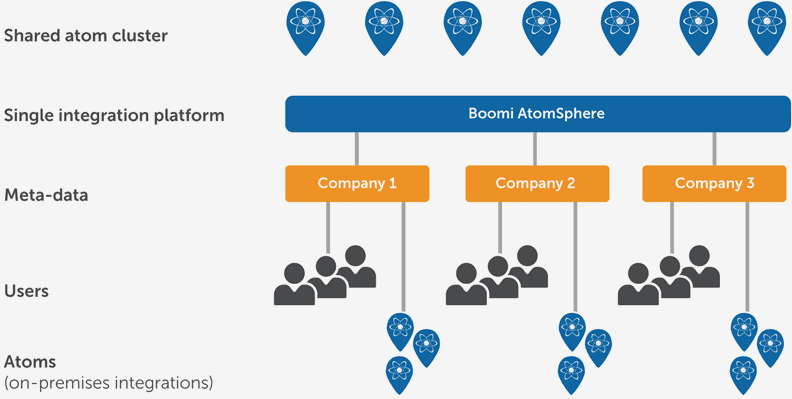Dell Boomi Update Demonstrates Power of Integration to Deliver Digital Transformation
Integration is proving a key part of meeting daily deliverables for digital transformation. Dell Boomi’s latest update for AtomSphere iPaaS is the largest yet -- with some 200 enhancements. IDN speaks with Boomi execs about a new intuitive UI for faster turn-arounds; a slew of new connectors; and deeper data management and governance.
by Vance McCarthy
Tags: AtomSphere, API, Boomi, cloud, data governance, deployment, digital transformation, Dell, EMC, golden record, hybrid, integration, iPaaS, REST,

director of product
& partner marketing

"Integration that is streamlined and rapid as possible is truly a foundation for digital transformation."
Integration & Web APIs
 Enterprise-Grade Integration Across Cloud and On-Premise
Enterprise-Grade Integration Across Cloud and On-PremiseAs digital enterprise programs ramp up, IT and business are finding integration is becoming a key part of meeting daily deliverables.
Dell Boomi’s latest update to its AtomSphere iPaaS is the largest yet -- with some 200 enhancements, among them: a slew of new connectors and deep support for how integration helps build apps faster and gets data where it needs to be.
Taken together, Boomi Fall 2016 features offer broad and deep support that will give companies the freedom and confidence to pursue a hybrid cloud strategy that works for them, Brett Stineman, director of product & partner marketing at Dell Boomi told IDN.
“Many companies want to go with best of breed apps. In that world, all things need to work together, reliably and easily. So, you need to make that integration for apps and data as streamlined and rapid as possible,” Stineman said. “That’s truly a foundation for digital transformation, and the innovation and agility that goes with it.”
The latest Dell Boomi AtomSphere upgrades address four (4) key areas:
- User experience
- Implementation & new integration accelerators
- data governance and
- deployment management
IDN takes a look at each.
Improved UI Rapid Results, More Productivity; APIs are Key
AtomSphere sports a new code-free UI allowing users to design and launch even complex, multi-step integration through a visual interface. Further, AtomSphere has improved how users can manage their workspace with easier navigation and customizable views.
“We let users set up a tightly defined environment with just the parts they need,” Stineman said.
AtomSphere is also adding what might be called ‘situational guides’ to help users navigate their way through more complex projects by providing embedded help and rich search functions. We’re also further speeding up integration tasks by adding simple drop-downs to let users answer questions like ‘What data sources do you need? Do you need credentials to access that data?’ and so forth,” Stineman said. There’s also more in-line help and documentation, he added.
Boomi also updated its UI to make APIs more readily available to an API developer. “Now the developer doesn’t need to understand the exact nature of the API,” Stineman said. He gave an example of a project to add new data fields to a customer service app. “At the backend, a team can create API access to an app or dataset. Then, the front-end team can work in Boomi to get that data from the backend,” he said.
This API support in AtomSphere also works for app-to-app integration where Boomi can feed data into billing and CRM systems through an API. It’s also proving useful for traditional EDI user cases to improve trading partner integration for transactional processes, he noted.
Connectors for Popular Services, Apps; Improved Implementation
These UI, API updates help drive quicker implementation for more use cases, as Boom expands its library of Boomi Connectors.
New additions include Amazon S3 (Simple Storage Service), Amazon SNS (Simple Notification Service), DoubleClick by Google, Intuit QuickBooks 2016, Magento, Marketo, Microsoft Azure SQL (database and data warehouse), Microsoft Azure Blob Storage, Slack, SugarCRM and UltiPro. Boomi also adds a new MQTT technology connector.
Updates for connectors are available for Microsoft Dynamics CRM, Hobsons, NetSuite, Oracle Taleo Cloud Service, Salesforce, and SAP, along with enhancing its connectors for database, HTTP, JMS and SFTP.
To speed up implementation, there is a new Boomi Process Library. In it are more than 25 pre-built integration processes that serve as examples and starting points for customers as they start their integrations. (These are available directly from inside the Boomi UI.)
Another aid to speed implementation, especially for long-tail, custom projects, is the updated Boomi Connector SDK. Developers can more easily create specific connectors on their own thanks to a newly-added Integration Pack User Interface – complete with demo web app and source code. To speed up creation of custom UIs, Stineman added.
Boosts to Data Governance, Data Quality & Security
For data governance, Boomi adds a records repository to persist data. “Now, users can define what a golden record is and what an entity is within the MDM repository,” Stineman said. Boomi tracks this data via metadata, he added.
To improve data quality, Boomi also has a quarantine repository where duplicate records or records that have extra information other than that in the main record can be more cleanly managed – without impacting the Golden Record. “Sometimes, a quarantined entity may have extra, valuable information, such as extra address info. You can now merge in this new data to update your Golden Record, and then get rid of the quarantined record,” he added.
Boomi also adds “source ranking,” designed to be valuable for companies working with varied data across multiple apps and data stores. “With source ranking, users can configure the MDM capability to automatically reject changes to a field if a higher-ranked application has already provided a value for that field,” Stineman said. This new feature joins other data stewardship improvements including selective merge, data steward role-based entitlements and an enhanced interface for the definition of governance rules.
Stineman shared a typical use case for this ‘source ranking’ feature.
When integrating multiple apps such as Salesforce, NetSuite, Workday and even on-prem ERP systems, users can now identify when changes get made to common fields in any of these apps, he said. Even more valuable, users can rank which source updates take priority. Other data stewardship improvements include selective merge, data steward role-based entitlements and an enhanced interface for the definition of governance rules.
For security, Boomi added ‘certificate management’ to help customers easily replace a certificate. Users can also be promoted to review certifications at least once a month to see any that might be expiring, and when necessary, import and deploy certificates any time before the expiration date. Users can also review an audit history of who changed a certificate and when.
Enterprise-Class Deployment Management for Cloud, Hybrid Ops
Boomi also improved its current release control features to make upgrades more seamless. “When upgrades are introduced the Boomi Atom Cloud utilizes a rolling restart, minimizing the impact on customers and eliminating downtime,” Stineman said.
Boomi has also added a new API deployment management console to provide users a central screen to view and manage all deployed APIs. This global view will give web services publishers a single location where they can track the deployment status of their published APIs, making API management easier and more efficient, he stated.
Further, to run integrations in a public cloud environment, it adds a new mechanism for a Boomi Atom to be deployed to the Microsoft Azure Cloud. Boomi customers can deploy an Atom directly from the Azure Marketplace and then connect their integration processes to the deployed Atom from the Boomi Platform.
EMC Eyes Boomi iPaaS as Foundation for Digital Transformation

These capabilities will likely take another step forward when EMC fully leverages Boomi’s capabilities as the Delll-EMC mega-merger settles in.
It’s worth noting that this latest Boomi upgrade (with 200+ upgrades) is largest and most expansive in the company’s history. Perhaps less noticed is the fact that Boomi was the only software-based business Dell kept going into the merger.
To Boomi’s CEO Chris McNabb, these are strong indications of how valuable EMC views Boomi’s capabilities to integrate apps across on-prem and cloud, and keep data consistent and reliable no matter where it lives.
“These are exciting times,” McNabb told IDN. “Candidly the leadership here is excited to bring forth a combined effort for enterprise solutions. We’ve got hardware, middleware and software solutions. Over the longer term, there are pieces in the EMC portfolio that seem to present a lot of cross-over opportunities and we’ll be looking for that make sense to work together on.”
IDN asked McNabb to name some of those Boomi+EMC projects, but he declined to get specific with us. That said, a quick look at EMC’s current portfolio uncovers some likely possibilities for how Boom’s API, iPaaS and data governance capabilities.
VirtuStream IaaS. Today it specializes in the SAP market to ‘lift-and-shift’ SAP ERP offerings to an elastic IaaS to and provide cloud capabilities as-a-service. Once a company moves their ERP to the cloud, the need for app and data integration increases. Further, end-to-end data governance becomes crucial.
Cloud Foundry. This open source project has big backing from EMC, and provides foundational capabilities that let companies rapidly build cloud and multi-tenant apps – and do it on the cloud of their choosing. That said, many cloud apps really need to integrate with other apps – and share data with them reliably to be of maximum value.
Internet of Things. EMC has several initiatives for Internet of Things IoT use cases, including object stores, software-defined storage and analytics. Boomi engineers have been looking at the problem even before the merger. Last summer, Boomi CTO Michael Morton was interviewed and gave some revealing insight about the convergence of data, analytics, security – and integration
In a commercial IoT deployment, it is very typical to have sensor/device data at the following four tiers: on the device, on an IoT Gateway, on servers, and in clouds. For integration, this means: new/different communication protocols, new data models, new security standards, computational consumption for operating on data based on the capabilities of the hardware where it resides (i.e. performing edge analytics), decisions on what data to copy, transform, and move, etc. Now you have to make integration decisions based on what you need to achieve for each of these four tiers
LEAP, Documentum – and aPaaS sector at large. Last fall, Dell EMCX debuted its LEAP content management platform. It complements the Dell EMC Documentum content server by letting users build apps can that leverage content on premises or in the cloud. Beyond this EMC-specific product, .as more and more companies building cloud-native apps, they will often expect those apps to be able to integrate easily with other cloud or on-prem content and resources.
Think of it this way, IT uses an aPaaS to avoid needing experts in every piece of new cloud app technologies (such as containerization, state management, scalalability, virtualization microservices, etc.) In this same way, IT will soon have simplified integration support – also without experts.
Enterprise Apps (SaaS and ISVs). EMC provides cloud, data and storage services to many well-known SaaS. Similarly, well-known SaaS and ISVs embed Boomi under the covers to provide their app and data integration. Brining more Boomi connectors and rich data governance certainly would be a key to delivering ‘best of breed; any-to-any on-demand integration for the digital enterprise.
All these are IDN's take on future possibilities (nothing formally announced as of yet). Readers can sign up for a free trial of Boomi Fall 2016 here.
Related:
- Tray Advantage Program To Speed, Simplify AI-Powered Automation for Enterprises
- Removing Barriers to Business by Enabling Agility & Control with Ecosystem Integration
- 98% of Enterprises Struggle To Maintain, Rebuild Integrations for Key Business Apps
- ThreatX Adds API Visibility, Protection Capabilities To Defend Against Real-Time Attacks
- Visibility and Transparency are Climbing the List of C-Suite Priorities in 2022
All rights reserved © 2025 Enterprise Integration News, Inc.


